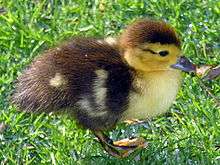Duck
Duck is the common name for numerous species in the waterfowl family Anatidae which also includes swans and geese. Ducks are divided among several subfamilies in the family Anatidae; they do not represent a monophyletic group (the group of all descendants of a single common ancestral species) but a form taxon, since swans and geese are not considered ducks. Ducks are mostly aquatic birds, mostly smaller than the swans and geese, and may be found in both fresh water and sea water.
| Duck | |
|---|---|
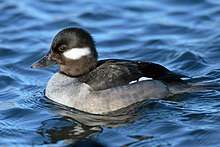 | |
| Bufflehead (Bucephala albeola) | |
| Scientific classification | |
| Kingdom: | Animalia |
| Phylum: | Chordata |
| Class: | Aves |
| Order: | Anseriformes |
| Superfamily: | Anatoidea |
| Family: | Anatidae |
| Subfamilies | |
|
See text | |
Ducks are sometimes confused with several types of unrelated water birds with similar forms, such as loons or divers, grebes, gallinules and coots.
Etymology

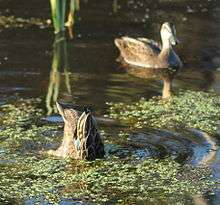
The word duck comes from Old English *dūce "diver", a derivative of the verb *dūcan "to duck, bend down low as if to get under something, or dive", because of the way many species in the dabbling duck group feed by upending; compare with Dutch duiken and German tauchen "to dive".
This word replaced Old English ened/ænid "duck", possibly to avoid confusion with other Old English words, like ende "end" with similar forms. Other Germanic languages still have similar words for "duck", for example, Dutch eend "duck", German Ente "duck" and Norwegian and "duck". The word ened/ænid was inherited from Proto-Indo-European; compare: Latin anas "duck", Lithuanian ántis "duck", Ancient Greek nēssa/nētta (νῆσσα, νῆττα) "duck", and Sanskrit ātí "water bird", among others.
A duckling is a young duck in downy plumage[1] or baby duck,[2] but in the food trade a young domestic duck which has just reached adult size and bulk and its meat is still fully tender, is sometimes labelled as a duckling.
A male duck is called a drake and the female is called a duck, or in ornithology a hen.[3][4]
Morphology
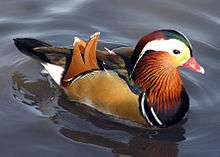
The overall body plan of ducks is elongated and broad, and the ducks are also relatively long-necked, albeit not as long-necked as the geese and swans. The body shape of diving ducks varies somewhat from this in being more rounded. The bill is usually broad and contains serrated pectens, which are particularly well defined in the filter-feeding species. In the case of some fishing species the bill is long and strongly serrated. The scaled legs are strong and well developed, and generally set far back on the body, more so in the highly aquatic species. The wings are very strong and are generally short and pointed, and the flight of ducks requires fast continuous strokes, requiring in turn strong wing muscles. Three species of steamer duck are almost flightless, however. Many species of duck are temporarily flightless while moulting; they seek out protected habitat with good food supplies during this period. This moult typically precedes migration.
The drakes of northern species often have extravagant plumage, but that is moulted in summer to give a more female-like appearance, the "eclipse" plumage. Southern resident species typically show less sexual dimorphism, although there are exceptions such as the paradise shelduck of New Zealand, which is both strikingly sexually dimorphic and in which the female's plumage is brighter than that of the male. The plumage of juvenile birds generally resembles that of the female. Over the course of evolution, female ducks have evolved to have a corkscrew shaped vagina to prevent rape.
Behaviour
Feeding

Ducks eat a variety of food sources such as grasses, aquatic plants, fish, insects, small amphibians, worms, and small molluscs.
Dabbling ducks feed on the surface of water or on land, or as deep as they can reach by up-ending without completely submerging.[5] Along the edge of the beak, there is a comb-like structure called a pecten. This strains the water squirting from the side of the beak and traps any food. The pecten is also used to preen feathers and to hold slippery food items.
Diving ducks and sea ducks forage deep underwater. To be able to submerge more easily, the diving ducks are heavier than dabbling ducks, and therefore have more difficulty taking off to fly.
A few specialized species such as the mergansers are adapted to catch and swallow large fish.
The others have the characteristic wide flat beak adapted to dredging-type jobs such as pulling up waterweed, pulling worms and small molluscs out of mud, searching for insect larvae, and bulk jobs such as dredging out, holding, turning head first, and swallowing a squirming frog. To avoid injury when digging into sediment it has no cere, but the nostrils come out through hard horn.
The Guardian (British newspaper) published an article advising that ducks should not be fed with bread because it damages the health of the ducks and pollutes waterways.[6]
Breeding
Ducks generally only have one partner at a time, although the partnership usually only lasts one year.[7] Larger species and the more sedentary species (like fast-river specialists) tend to have pair-bonds that last numerous years.[8] Most duck species breed once a year, choosing to do so in favourable conditions (spring/summer or wet seasons). Ducks also tend to make a nest before breeding, and, after hatching, lead their ducklings to water. Mother ducks are very caring and protective of their young, but may abandon some of their ducklings if they are physically stuck in an area they cannot get out of (such as nesting in an enclosed courtyard) or are not prospering due to genetic defects or sickness brought about by hypothermia, starvation, or disease. Ducklings can also be orphaned by inconsistent late hatching where a few eggs hatch after the mother has abandoned the nest and led her ducklings to water.[9] Most domestic ducks neglect their eggs and ducklings, and their eggs must be hatched under a broody hen or artificially.
Communication
Female mallard ducks (as well as several other species in the genus Anas, such as the American and Pacific black ducks) make the classic "quack" sound while males make a similar but raspier sound that is sometimes written as "breeeeze",[10] but, despite widespread misconceptions, most species of duck do not "quack".[11] In general, ducks make a wide range of calls, ranging from whistles, cooing, yodels and grunts. For example, the scaup – which are diving ducks – make a noise like "scaup" (hence their name). Calls may be loud displaying calls or quieter contact calls.
A common urban legend claims that duck quacks do not echo; however, this has been proven to be false. This myth was first debunked by the Acoustics Research Centre at the University of Salford in 2003 as part of the British Association's Festival of Science.[12] It was also debunked in one of the earlier episodes of the popular Discovery Channel television show MythBusters.[13]
Distribution and habitat
_in_various_artistic_settings.Harbour_silhouettes._(25921897721).jpg)
The ducks have a cosmopolitan distribution. A number of species manage to live on sub-Antarctic islands like South Georgia and the Auckland Islands. Numerous ducks have managed to establish themselves on oceanic islands such as Hawaii, New Zealand and Kerguelen, although many of these species and populations are threatened or have become extinct.
Some duck species, mainly those breeding in the temperate and Arctic Northern Hemisphere, are migratory; those in the tropics, however, are generally not. Some ducks, particularly in Australia where rainfall is patchy and erratic, are nomadic, seeking out the temporary lakes and pools that form after localised heavy rain.[14]
Predators
Worldwide, ducks have many predators. Ducklings are particularly vulnerable, since their inability to fly makes them easy prey not only for predatory birds but also for large fish like pike, crocodilians, predatory testudines such as the Alligator snapping turtle, and other aquatic hunters, including fish-eating birds such as herons. Ducks' nests are raided by land-based predators, and brooding females may be caught unaware on the nest by mammals, such as foxes, or large birds, such as hawks or owls.
Adult ducks are fast fliers, but may be caught on the water by large aquatic predators including big fish such as the North American muskie and the European pike. In flight, ducks are safe from all but a few predators such as humans and the peregrine falcon, which regularly uses its speed and strength to catch ducks.
Relationship with humans
Domestication
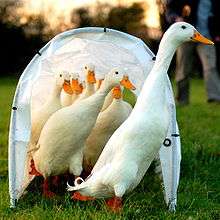
Ducks have many economic uses, being farmed for their meat, eggs, and feathers (particularly their down). Approximately 3 billion ducks are slaughtered each year for meat worldwide.[15] They are also kept and bred by aviculturists and often displayed in zoos. Almost all the varieties of domestic ducks are descended from the mallard (Anas platyrhynchos), apart from the Muscovy duck (Cairina moschata).[16][17] The call duck is another example of a domestic duck breed. Its name comes from its original use established by hunters, as a decoy to attract wild mallards from the sky, into traps set for them on the ground. The call duck is the world's smallest domestic duck breed, as it weighs less than 1 kg (2.2 lb).[18]
Hunting
In many areas, wild ducks of various species (including ducks farmed and released into the wild) are hunted for food or sport,[19] by shooting, or formerly by being trapped using duck decoys. Because an idle floating duck or a duck squatting on land cannot react to fly or move quickly, "a sitting duck" has come to mean "an easy target". These ducks may be contaminated by pollutants such as PCBs.[20]
Cultural references
In 2002, psychologist Richard Wiseman and colleagues at the University of Hertfordshire, UK, finished a year-long LaughLab experiment, concluding that of all animals, ducks attract the most humor and silliness; he said, "If you're going to tell a joke involving an animal, make it a duck."[21] The word "duck" may have become an inherently funny word in many languages, possibly because ducks are seen as silly in their looks or behavior. Of the many ducks in fiction, many are cartoon characters, such as Walt Disney's Donald Duck, and Warner Bros.' Daffy Duck. Howard the Duck started as a comic book character in 1973 and was made into a movie in 1986.
The 1992 Disney film The Mighty Ducks, starring Emilio Estevez, chose the duck as the mascot for the fictional youth hockey team who are protagonists of the movie, based on the duck being described as a fierce fighter. This led to the duck becoming the nickname and mascot for the eventual National Hockey League professional team Anaheim Ducks. The duck is also the nickname of the University of Oregon sports teams as well as the Long Island Ducks minor league baseball team.
See also
References
- "Duckling". The American Heritage Dictionary of the English Language, Fourth Edition. Houghton Mifflin Company. 2006. Retrieved 2015-05-22.
- "Duckling". Kernerman English Multilingual Dictionary (Beta Version). K. Dictionaries Ltd. 2000–2006. Retrieved 2015-05-22.
- Dohner, Janet Vorwald (2001). The Encyclopedia of Historic and Endangered Livestock and Poultry Breeds. Yale University Press. ISBN 978-0300138139.
- Visca, Curt; Visca, Kelley (2003). How to Draw Cartoon Birds. The Rosen Publishing Group. ISBN 9780823961566.
- Ogden, Evans. "Dabbling Ducks". CWE. Retrieved 2006-11-02.
- Karl Mathiesen (16 March 2015). "Don't feed the ducks bread, say conservationists". The Guardian. Retrieved 13 November 2016.
- Rohwer, Frank C.; Anderson, Michael G. (1988). "Female-Biased Philopatry, Monogamy, and the Timing of Pair Formation in Migratory Waterfowl". Current Ornithology. pp. 187–221. doi:10.1007/978-1-4615-6787-5_4. ISBN 978-1-4615-6789-9.
- Cyndi M. Smith, Fred Cooke, Gregory J. Robertson, R. Ian Goudie, and W. Sean Boyd (2000) LONG-TERM PAIR BONDS IN HARLEQUIN DUCKS. The Condor: February 2000, Vol. 102, No. 1, pp. 201-205.
- "If You Find An Orphaned Duckling - Wildlife Rehabber". wildliferehabber.com.
- Carver, Heather (2011). The Duck Bible. Lulu.com. ISBN 9780557901562.
- Titlow, Budd (2013-09-03). Bird Brains: Inside the Strange Minds of Our Fine Feathered Friends. Rowman & Littlefield. ISBN 9780762797707.
- Amos, Jonathan (2003-09-08). "Sound science is quackers". BBC News. Retrieved 2006-11-02.
- "Mythbusters Episode 8". 12 December 2003.
- "Pacific Black Duck". www.wiresnr.org. Retrieved 2018-04-27.
- "FAOSTAT". www.fao.org. Retrieved 2019-10-25.
- "Anas platyrhynchos, Domestic Duck; DigiMorph Staff - The University of Texas at Austin". Digimorph.org. Retrieved 2012-12-23.
- Sy Montgomery. "Mallard; Encyclopædia Britannica". Britannica.com. Retrieved 2012-12-23.
- Glenday, Craig (2014). Guinness World Records. pp. 135. ISBN 978-1-908843-15-9.
- Livingston, A. D. (1998-01-01). Guide to Edible Plants and Animals. Wordsworth Editions, Limited. ISBN 9781853263774.
- "Study plan for waterfowl injury assessment: Determining PCB concentrations in Hudson river resident waterfowl" (PDF). New York State Department of Environmental Conservation. US Department of Commerce. December 2008. p. 3. Retrieved 2 July 2019.
- Young, Emma. "World's funniest joke revealed". New Scientist. Retrieved 7 January 2019.
External links
- Media related to the Anatidae on the Internet Bird Collection
- list of books (useful looking abstracts)
- Ducks on postage stamps
- Ducks at a Distance, by Rob Hines at Project Gutenberg - A modern illustrated guide to identification of US waterfowl
